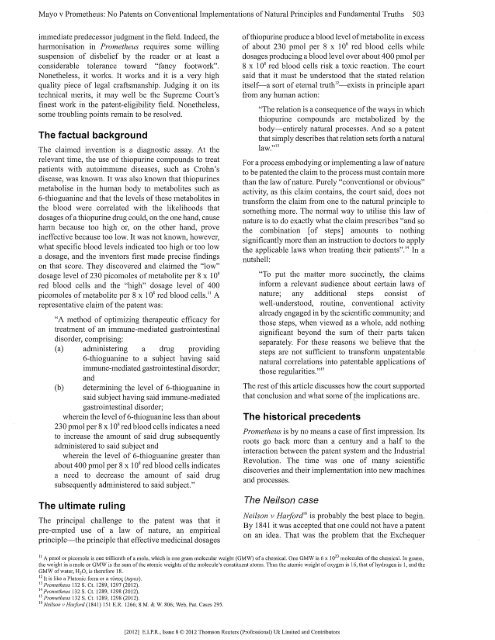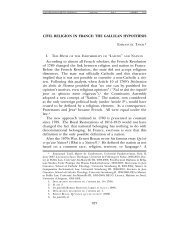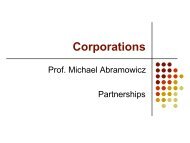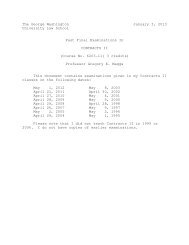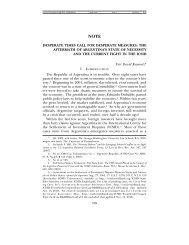Mayo v Prometheus - Gwu - George Washington University
Mayo v Prometheus - Gwu - George Washington University
Mayo v Prometheus - Gwu - George Washington University
You also want an ePaper? Increase the reach of your titles
YUMPU automatically turns print PDFs into web optimized ePapers that Google loves.
<strong>Mayo</strong> v <strong>Prometheus</strong>: No Patents on Conventional Implementations ofNatural Principles and Fundamental Truths 503<br />
immediate predecessor judgment in the field. Indeed, the<br />
harmonisation in <strong>Prometheus</strong> requires some willing<br />
suspension of disbelief by the reader or at least a<br />
considerable tolerance toward "fancy footwork".<br />
Nonetheless, it works. It works and it is a very high<br />
quality piece of legal craftsmanship. Judging it on its<br />
technical merits, it may well be the Supreme Court's<br />
finest work in the patent-eligibility field. Nonetheless,<br />
some troubling points remain to be resolved.<br />
The factual background<br />
The claimed invention is a diagnostic assay. At the<br />
relevant time, the use of thiopurine compounds to treat<br />
patients with autoimmune diseases, such as Crohn's<br />
disease, was known. It was also known that thiopurines<br />
metabolise in the human body to metabolites such as<br />
6-thioguanine and that the levels of these metabolites in<br />
the blood were correlated with the likelihoods that<br />
dosages of a thiopurine drug could, on the one hand, cause<br />
harm because too high or, on the other hand, prove<br />
ineffective because too low. It was not known, however,<br />
what specific blood levels indicated too high or too low<br />
a dosage, and the inventors first made precise findings<br />
on that score. They discovered and claimed the "low"<br />
dosage level of 230 picomoles of metabolite per 8 x 10 8<br />
red blood cells and the "high" dosage level of 400<br />
picomoles of metabolite per 8 x 10' red blood cells. 11 A<br />
representative claim of the patent was:<br />
"A method of optimizing therapeutic efficacy for<br />
treatment of an immune-mediated gastrointestinal<br />
disorder, comprising:<br />
(a) administering a drug providing<br />
6-thioguanine to a subject having said<br />
immune-mediated gastrointestinal disorder;<br />
and<br />
(b) determining the level of 6-thioguanine in<br />
said subject having said immune-mediated<br />
gastrointestinal disorder;<br />
wherein the level of 6-thioguanine less than about<br />
230 pmol per 8 x 10 8 red blood cells indicates a need<br />
to increase the amount of said drug subsequently<br />
administered to said subject and<br />
wherein the level of 6-thioguanine greater than<br />
about 400 pmol per 8 x 10 8 red blood cells indicates<br />
a need to decrease the amount of said drug<br />
subsequently administered to said subject."<br />
The ultimate ruling<br />
The principal challenge to the patent was that it<br />
pre-empted use of a law of nature, an empirical<br />
principle-the principle that effective medicinal dosages<br />
ofthiopurine produce a blood level of metabolite in excess<br />
of about 230 pmol per 8 x 10 8 red blood cells while<br />
dosages producing a blood level over about 400 pmol per<br />
8 x 1 0' red blood cells risk a toxic reaction. The court<br />
said that it must be understood that the stated relation<br />
itself-a sort of eternal truth 12 -exists in principle apart<br />
from any human action:<br />
"The relation is a consequence of the ways in which<br />
thiopurine compounds are metabolized by the<br />
body-entirely natural processes. And so a patent<br />
that simply describes that relation sets forth a natural<br />
law." 13<br />
For a process embodying or implementing a law of nature<br />
to be patented the claim to the process must contain more<br />
than the law of nature. Purely "conventional or obvious"<br />
activity, as this claim contains, the court said, does not<br />
transform the claim from one to the natural principle to<br />
something more. The nonnal way to utilise this law of<br />
nature is to do exactly what the claim prescribes "and so<br />
the combination [of steps] amounts to nothing<br />
significantly more than an instruction to doctors to apply<br />
the applicable laws when treating their patients". 14 In a<br />
nutshell:<br />
"To put the matter more succinctly, the claims<br />
inform a relevant audience about certain laws of<br />
nature; any additional steps consist of<br />
well-understood, routine, conventional activity<br />
already engaged in by the scientific community; and<br />
those steps, when viewed as a whole, add nothing<br />
significant beyond the sum of their parts taken<br />
separately. For these reasons we believe that the<br />
steps are not sufficient to transform unpatentable<br />
natural correlations into patentable applications of<br />
those regularities." 15<br />
The rest of this article discusses how the court supported<br />
that conclusion and what some of the implications are.<br />
The historical precedents<br />
<strong>Prometheus</strong> is by no means a case of first impression. Its<br />
roots go back more than a centuty and a half to the<br />
interaction between the patent system and the Industrial<br />
Revolution. The time was one of many scientific<br />
discoveries and their implementation into new machines<br />
and processes.<br />
The Neilson case<br />
Neilson v Hmford 16 is probably the best place to begin.<br />
By 1841 it was accepted that one could not have a patent<br />
on an idea. That was the problem that the Exchequer<br />
11 A pmol or picomole is one trillionth of a mole, which is one gram molecular weight (GMW) of a chemical. One GMW is 6 x 10 23 molecules of the chemical. In grams,<br />
the weight in a mole or GMW is the sum of the atomic weights of the molecule's constituent atoms. Thus the atomic weight of oxygen is 16, that of hydrogen is 1, and the<br />
GMW of water, H 2 0, is therefore 18.<br />
12 It is like a Platonic form or a n)no


